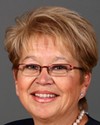Thank you very much. Merci beaucoup.
I would like to thank everyone for being here today to allow each of the groups to speak on behalf of aboriginal women.
I'll begin by sharing a bit of history. In 2004 the Native Women's Association of Canada was funded for the Sisters In Spirit campaign, which was a campaign to raise awareness about missing and murdered aboriginal women and girls in Canada. At the time, it was believed that over the past 30 years, approximately 500 aboriginal women and girls had gone missing or had been found murdered in communities across Canada. However, government, society, and the media remained silent on this issue.
In 2010, the silence has been broken, but we still have a lot of work to do.
In 2005 the Native Women's Association of Canada was funded for the Sisters In Spirit research, education, and policy initiative, which was a five-year initiative to provide evidence of the number of missing and murdered aboriginal women and girls in Canada, as well as the root causes, circumstances, and trends of violence that lead to disappearance and death.
This has not been an easy task. In terms of our research methodology, we started from scratch. Previous to this research initiative there was no real methodology for collecting community-based information and providing evidence based on police data and criminal justice data for aboriginal women who have gone missing or been found murdered. As was identified by the Métis Nation of Saskatchewan, there is very little information relating to aboriginal identity, specifically Métis, first nations, or Inuit identity of victims of crime.
The evidence gathered over the past five years has not simply been about research or numbers, but about the lives of women and girls who are lost. The stories that have been shared by families to honour the lives of missing and murdered sisters, mothers, daughters, grandmothers, and aunties remind us that each life was beautiful, each woman was strong, and each person is missed very much by her family.
We have gathered life stories and statistical information that have been a very valuable part of our research initiative. Using a mixed method approach, the method has evolved based on a collaborative and reciprocal process privileging the experiences of aboriginal women and girls and their families, and allowing for different perspectives, cultures, values, traditions, and needs, all of which need to be shared.
The research process is guided by the cultural and ethical values of caring, sharing, trust, and strength, which are important to this type of research because of their sensitive nature and the understanding that many of these voices, and the voices of families, have been lost over the previous generation.
The stories have also helped us to understand the circumstances, root causes, and trends surrounding missing and murdered aboriginal women, and to identify appropriate responses for action. It is aboriginal women and girls, families, and communities who understand what the most appropriate actions must be.
We have also taken seriously the need to successfully relay our findings back to the families, aboriginal communities, as well as the general public, provincial and federal governments, and various government departments, which all have a stake in this issue.
Over the course of this initiative, we have also learned there is no comprehensive source of data of missing and murdered aboriginal women and girls. Based on police data and jurisdictions across the country, police do not collect the ethnic identity for victims in a comprehensive or any kind of systemic way. The victims of crime are often gone without being identified.
NWAC now holds the only source of data of both missing and murdered women. We have been working very closely with police, including the RCMP, to make sure this data is verified and accurate based on information from their files.
In terms of the broader issues of violence against aboriginal women and girls, we have come to understand that academic literature and literature on violence tends to focus on family violence or domestic violence, but the experiences of aboriginal women and girls are much broader. It is also not just an aboriginal issue or women's issue, but an issue that needs to be addressed by all Canadians. We need to make sure that all the appropriate departments and ministries within government acknowledge that this is an issue of justice, public safety, culture, housing, economic security, and so on.
Over the course of the past five years, we have come to understand that violence against aboriginal women and girls is actually systemic, gendered racism and violence facing aboriginal women, which is the result of a legacy of colonization that devalues aboriginal women in Canadian society.
This devaluing of aboriginal women is evident when examining the disproportionate experiences of violence, the high rates of disappearance, and the disturbingly high number of murders among aboriginal women and girls. What is even more disturbing, however, is the very low clearance rate of homicides. We have recently found that the clearance rate is actually a very low 53% of all homicide cases in Canada, compared to Statistics Canada's report that found in 2005 that homicide cases in Canada overall had an 84% clearance rate.
What we also know, based on information collected through our research initiative, is that experiences of violence and the silence surrounding the experiences of violence are often mistaken for acceptance.
We know that aboriginal identity is one of the strongest predictors of violence in Canada. Aboriginal peoples are three times more likely to experience violence than any other group and, as was mentioned by Chief Cloud, aboriginal women are 3.5 times more likely to experience violence.
According to Statistics Canada, aboriginal women are also seven times more likely to be murdered than non-aboriginal women in Canada. Violence is often unreported in 60% of cases, it is believed, and violence is often linked to circumstances of vulnerability including low income, housing insecurity, age--an issue of youth--as well as geography, and sex.
Our recent research findings have shown that aboriginal women and girls are also as likely to be killed by a stranger or an acquaintance as they are by an intimate partner. This is very different from the experiences of non-aboriginal women in Canada, whose homicide rates are often attributed to intimate partner violence.
In terms of the research findings that we released today, in a report entitled What Their Stories Tell Us, we know that there are 582 cases of missing or murdered aboriginal women and girls across the country. These cases identify a disproportionately high number of missing and murdered women in the western provinces, as well as a disproportionately high number that we have identified over the past 10 years. Two-thirds of the cases have come from the western provinces, British Columbia, Alberta, Manitoba, and Saskatchewan. British Columbia has the highest number of cases as well as the highest percentage of cases, with 160.
We also know that a great majority of the women were young. More than half of these women and girls were under the age of 31. If we are going to design measures that appropriately address issues of violence, we must take into account the needs of young women and youth. Many women were also mothers. As I mentioned before, we know that nearly half of the cases of murdered women and girls remain unsolved cases, with only 53% of the cases having a clearance rate.
We know that the majority of cases also occur in urban areas, but that we can't forget the circumstances of violence affecting on-reserve communities, rural and remote areas, northern communities, Métis territories, and having an identity-specific response to meet the cultural needs of victims of crime.
In summarizing the research findings and identifying trends related to root causes and circumstances, there are a number of key findings that should inform policy decisions, victim services, and action.












